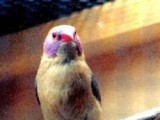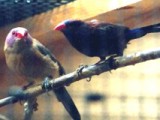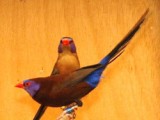Violet-eared Waxbill
Violet-eared Waxbill
(Uraeginthus granatina)
The lovely 4½” Violet-eared Waxbill (Uraeginthus granatina) is often considered by many as the most beautiful and desirable waxbill available.
The male has a deep rich reddish-brown on the head, back and wings. The variation is from chestnut on the head to a darker more brown shade on the primary flights. The upper tail coverts are brilliant deep blue, and the tail is a dark grayish-black edged on the tips and sides in a dark blue.
The forehead is a vivid blue and a long chin and throat accent is black. The beak is a bright shade of wine red, and the reddish eye is surrounded by a bright red eye ring. A large flaring cheek and facial area is a rich purplish-blue. The chest and underparts are a beautiful shade of burgundy-brown becoming progressively less bright on the abdomen and ending in a dark dull shade under the vent. The underside of the tail is a dark, dull blue.Violet-eared Waxbill pair (Uraeginthus granatina) – photo by Randy Taylor
Females are duller in coloration. Upperparts are a dull, pale brown. The cheek patch is much paler, and the blue of the forehead is just barely present. The black of the throat is reduced to a pale gray which changes to a bright fawn tinged with red on most of the underparts. The wings are duller, but the tail and bright blue upper tail coverts are similar to the male. The beak is the same as the males but duller.
Hen Violet-eared Waxbill (Uraeginthus granatina) – photo by Randy TaylorThe Violet-eared Waxbill is a solitary species and must be kept one pair per flight or aviary.
A 50/50 finch seed and wild seed is ideal. They also appreciate soaked finch seed, egg food, fresh greens, vegetables and mealworms.
Incubation time is twelve to fourteen days, and the young fledge in about three weeks looking much like dull copies of the female. Sexes can be determined after about three or four months.
This site uses Akismet to reduce spam. Learn how your comment data is processed.




Leave a Reply
You must be logged in to post a comment.